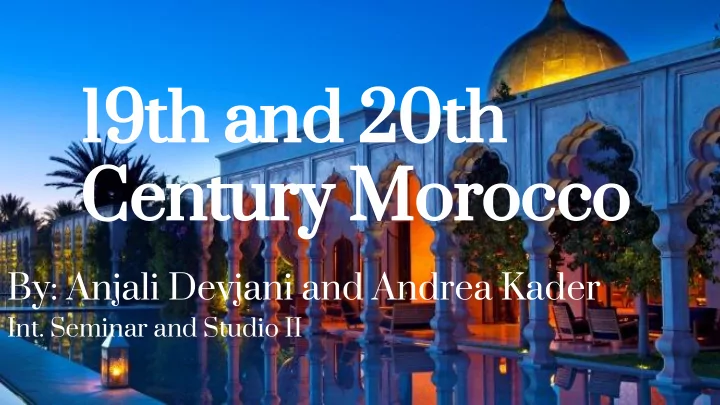

19th and 20th Century Morocco By: Anjali Devjani and Andrea Kader Int. Seminar and Studio II
Morocco -A country in northern Africa -Population: 33 million -Officially known as the Kingdom of Morocco, following the end of the French reign in 1956 -Official languages: Arabic and French -Religious affiliation: Islam -
The role of the Morocco The role of the Jewish women in Jews in Morocco nineteenth Morocco during during the the nineteenth nineteenth century century Century
Thesis statement In the Nineteenth century the Jewish culture, especially the Jewish women, made a significant impact in the Moroccan society and broke pre established paradigms about the traditional gender roles. They influenced Morocco not only in a historical manner, but also from a social and artistic point of view.
19th Century Jewish community- largest one in North Africa. Morocco was a desired area by all of the European powers- invaded by the English, French and Spanish. Jews were favored by this period of invasion- consular representatives, officials, negotiators, and administrators at the Moroccan court.
Jewish Women-Early 19th Century "The beauty of the Jewesses of Morocco has a character of its own, unknown in other countries. It is an opulent and splendid beauty, with large black eyes, broad, low forehead, full red lips, and statuesque form." -Edmondo de Amicis
La Belle Juive La Juive (1853)- Jacques A Jewess of Halévy Tetuan by Jean- Ivanhoe (1820)-Sir Walter François Scott Portaels (1879).
Jewish Women in European Art Young Moroccan Jewish with roses by woman in Jean Morocco by Francois Alfred Portaels Dehodencq
Eugene Delacroix
Studio Project #1
Late 19th Century 1860- Alliance Israelite Universelle Education- Changed the pre established archetypes of the traditional gender roles
Moroccan Jewish Culture Henna Party Mimouna
Studio Project
19th 20th Century -Norm Of Modesty: total seclusion of married women. Obligated wives to cover their hair and remain at home, out of public view, segregated from men. -Purpose: Reinforce Islamic culture and traditions, control the expansion of the Jews. -Conflicts, then caused a move back into tradition...
20th Century -End of the French Protectorate in 1956, Morocco declared a constitutional monarchy Coat of Arms (1957) -Thus bringing out a nationalist movement within the country Nationalists -Thesis: The growth of patriotism caused an increase of passion for the culture and traditions of Morocco -Traditional Moroccan fashion, in regard to objects that adorn the body, was brought into modernity and the 20th Century.
What is traditional Morocco? -Location allowed for extraneous influences from varying countries -Along major trade route of Islamic cultures, amongst others -The European fashion along with the Islamic culture and tradition are major attributes of ‘traditional Morocco’ -The combination of ideas and skillsets formed the style that is Moroccan fashion
Traditional patterns -Moroccan designs have distinct patterns with bright colors
After Before Moroccan tradition was brought into modern fashion
Riad: is a traditional Moroccan house or palace with an interior garden or courtyard -They incorporated organic and natural elements into their daily lives … as well as the Fashion...
Lost Wax Jewelry Casting Eight Pointed Star Studio Project 1: Jewelry Piece, process
Studio Project 2: Printmaking
Silk Scarf Printmaking: Process
Thank You!
Recommend
More recommend